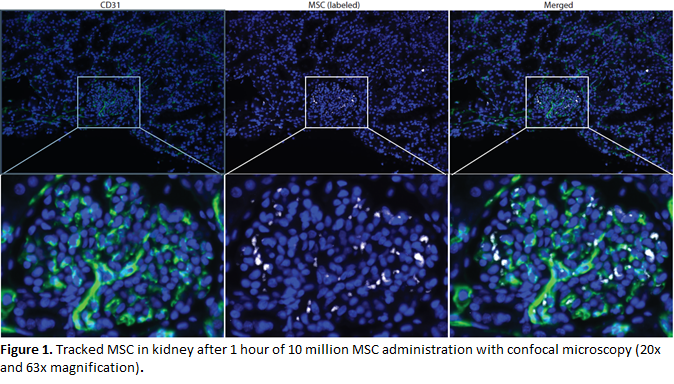What Happens When You Administer Mesenchymal Stromal Cells During Normothermic Machine Perfusion of Porcine Kidneys: Possible and Helpful or Not?
1Nuffield Department of Surgical Sciences, University of Oxford, Oxford, United Kingdom, 2Department of Internal Medicine, Nephrology and Transplantation, Erasmus MC, University Medical Center, Rotterdam, Netherlands
Meeting: 2020 American Transplant Congress
Abstract number: D-312
Keywords: Machine preservation, Pig, Renal ischemia, Stem cells
Session Information
Session Name: Poster Session D: Cellular Therapies, Tissue Engineering / Regenerative Medicine
Session Type: Poster Session
Date: Saturday, May 30, 2020
Session Time: 3:15pm-4:00pm
 Presentation Time: 3:30pm-4:00pm
Presentation Time: 3:30pm-4:00pm
Location: Virtual
*Purpose: Donation after circulatory death kidneys are widely used to increase the donor pool, despite their inferior quality. Normothermic machine perfusion (NMP) could provide a platform to assess organ viability prior to transplantation and offers the unique opportunity for active interventions to an isolated organ. Mesenchymal stromal cells (MSC) have been shown to possess potent anti-inflammatory and regenerative properties ameliorating ischaemia reperfusion injury. However, the most common delivery route of MSC is intravenous infusion, which is associated with off-target distribution. We aimed to determine the dose of MSC needed to allow successful homing in donor kidneys during NMP without adversely affecting renal perfusion dynamics.
*Methods: Porcine slaughterhouse kidneys with 20 min warm ischaemia were retrieved and underwent 3h hypothermic machine perfusion followed by NMP for 7h. Following 1h of NMP, either a vehicle, 2 x 106, 10 x 106 or 50 x 106 labelled (Qdots) porcine adipose derived MSC (n=3 per group) were injected into the cannulated renal artery. Physiological recordings were taken regularly. Perfusate, urine and biopsies were obtained for biomarker analysis and to locate MSC.
*Results: No difference was found in renal blood flow (p=0.668), renal resistance (p=0.828) and urine production (p=0.307) between all MSC groups compared to control. Damage markers LDH and AST increased during NMP and remained similar between groups (p=0.816 and p=0.312). Confocal microscopy demonstrated mainly glomerular localization of MSC (Figure 1), but they were also observed in the capillary network around the tubules. Additionally, a significant percentage of localised MSC was observed in the glomeruli in the 10 and 50 million MSC groups compared to 2 million MSC group (p=0.002 and p<0.0001). No differences were observed between the 2 and 10 million MSC groups (p>0.05). There is a significant increase in secreted inflammatory mediator PGE2 with time in all groups (p<0.05).
*Conclusions: Administration of different doses of MSC to the donor kidney during NMP is safe and feasible. MSC successfully homed in the glomeruli. This model provides us with the opportunity of getting a better insight in the interaction between MSC and the injured donor kidney: how do MSC or their released secretome affect tissue integrity and renal function.
To cite this abstract in AMA style:
Rozenberg K, Knijff L, Sierra-Parraga J, Faro LLo, Hoogduijn M, Baan C, Hunter J, Ploeg R. What Happens When You Administer Mesenchymal Stromal Cells During Normothermic Machine Perfusion of Porcine Kidneys: Possible and Helpful or Not? [abstract]. Am J Transplant. 2020; 20 (suppl 3). https://atcmeetingabstracts.com/abstract/what-happens-when-you-administer-mesenchymal-stromal-cells-during-normothermic-machine-perfusion-of-porcine-kidneys-possible-and-helpful-or-not/. Accessed December 15, 2025.« Back to 2020 American Transplant Congress

